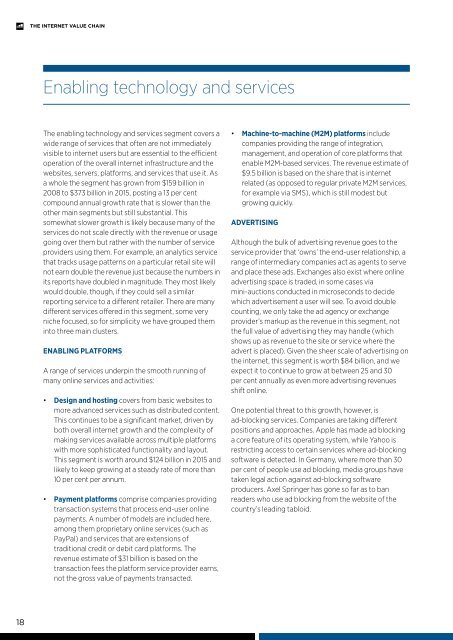The Internet Value Chain
GSMA_The-internet-Value-Chain_WEB
GSMA_The-internet-Value-Chain_WEB
Create successful ePaper yourself
Turn your PDF publications into a flip-book with our unique Google optimized e-Paper software.
THE INTERNET VALUE CHAIN<br />
Enabling technology and services<br />
<strong>The</strong> enabling technology and services segment covers a<br />
wide range of services that often are not immediately<br />
visible to internet users but are essential to the efficient<br />
operation of the overall internet infrastructure and the<br />
websites, servers, platforms, and services that use it. As<br />
a whole the segment has grown from $159 billion in<br />
2008 to $373 billion in 2015, posting a 13 per cent<br />
compound annual growth rate that is slower than the<br />
other main segments but still substantial. This<br />
somewhat slower growth is likely because many of the<br />
services do not scale directly with the revenue or usage<br />
going over them but rather with the number of service<br />
providers using them. For example, an analytics service<br />
that tracks usage patterns on a particular retail site will<br />
not earn double the revenue just because the numbers in<br />
its reports have doubled in magnitude. <strong>The</strong>y most likely<br />
would double, though, if they could sell a similar<br />
reporting service to a different retailer. <strong>The</strong>re are many<br />
different services offered in this segment, some very<br />
niche focused, so for simplicity we have grouped them<br />
into three main clusters.<br />
ENABLING PLATFORMS<br />
A range of services underpin the smooth running of<br />
many online services and activities:<br />
• Design and hosting covers from basic websites to<br />
more advanced services such as distributed content.<br />
This continues to be a significant market, driven by<br />
both overall internet growth and the complexity of<br />
making services available across multiple platforms<br />
with more sophisticated functionality and layout.<br />
This segment is worth around $124 billion in 2015 and<br />
likely to keep growing at a steady rate of more than<br />
10 per cent per annum.<br />
• Payment platforms comprise companies providing<br />
transaction systems that process end-user online<br />
payments. A number of models are included here,<br />
among them proprietary online services (such as<br />
PayPal) and services that are extensions of<br />
traditional credit or debit card platforms. <strong>The</strong><br />
revenue estimate of $31 billion is based on the<br />
transaction fees the platform service provider earns,<br />
not the gross value of payments transacted.<br />
• Machine-to-machine (M2M) platforms include<br />
companies providing the range of integration,<br />
management, and operation of core platforms that<br />
enable M2M-based services. <strong>The</strong> revenue estimate of<br />
$9.5 billion is based on the share that is internet<br />
related (as opposed to regular private M2M services,<br />
for example via SMS), which is still modest but<br />
growing quickly.<br />
ADVERTISING<br />
Although the bulk of advertising revenue goes to the<br />
service provider that ‘owns’ the end-user relationship, a<br />
range of intermediary companies act as agents to serve<br />
and place these ads. Exchanges also exist where online<br />
advertising space is traded, in some cases via<br />
mini-auctions conducted in microseconds to decide<br />
which advertisement a user will see. To avoid double<br />
counting, we only take the ad agency or exchange<br />
provider’s markup as the revenue in this segment, not<br />
the full value of advertising they may handle (which<br />
shows up as revenue to the site or service where the<br />
advert is placed). Given the sheer scale of advertising on<br />
the internet, this segment is worth $84 billion, and we<br />
expect it to continue to grow at between 25 and 30<br />
per cent annually as even more advertising revenues<br />
shift online.<br />
One potential threat to this growth, however, is<br />
ad-blocking services. Companies are taking different<br />
positions and approaches. Apple has made ad blocking<br />
a core feature of its operating system, while Yahoo is<br />
restricting access to certain services where ad-blocking<br />
software is detected. In Germany, where more than 30<br />
per cent of people use ad blocking, media groups have<br />
taken legal action against ad-blocking software<br />
producers. Axel Springer has gone so far as to ban<br />
readers who use ad blocking from the website of the<br />
country’s leading tabloid.<br />
18


